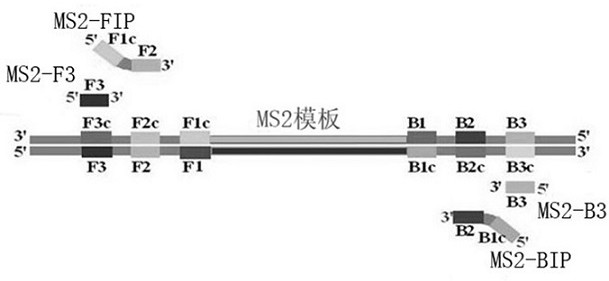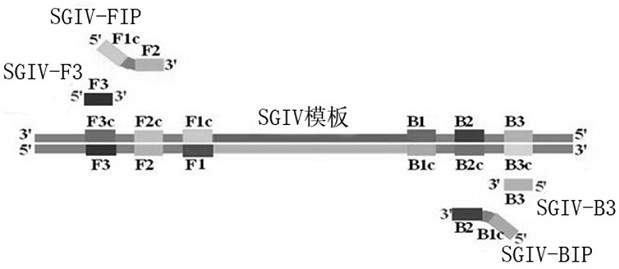An Overlapping Loop-Mediated Isothermal Nucleic Acid Amplification Technique
A ring-mediated isothermal and nucleic acid technology, applied in the field of warm nucleic acid amplification technology, can solve the problems of difficult double gene or even multigene detection, large reaction interference, cumbersome and complicated system, etc., and achieve simple primer design method and high reaction efficiency , the effect of accurate response results
- Summary
- Abstract
- Description
- Claims
- Application Information
AI Technical Summary
Problems solved by technology
Method used
Image
Examples
Embodiment 1
[0035] Example 1: Design overlapping primers and amplify MS2-SGIV-specific gene effect display
[0036] 1. Design primers to detect MS2-specific genes. The MS2 gene sequence is shown in SEQ ID NO.1, and the MS2 primers are designed as figure 1 As shown, the primer sequences are specifically shown in Table 1, and the reaction system is shown in Table 2.
[0037] Table 1 MS2 primer sequences for loop-mediated isothermal nucleic acid amplification
[0038]
[0039] Table 2 Reaction system
[0040]
[0041] The above reaction system was carried out in a constant temperature water bath at 65°C for 60 minutes, and nucleic acid electrophoresis was carried out. The results were as follows: figure 1 (1~4). figure 2 Among them, M is DL2000 DNA marker, 1 and 2 are MS2 reaction gel images, LAMP reacts normally, 3 and 4 are negative controls, only PUC19 plasmid DNA is added as negative control.
[0042] 2. Design primers to detect SGIV-specific genes. The SGIV gene sequence is...
Embodiment 2
[0066] Example 2: Design overlapping primers and amplify CCHFV-HCV specific gene effect display
[0067] 1. Design primers to detect CCHFV-specific genes. The CCHFV gene sequence is shown in SEQ ID NO.3, and the CCHFV primers are designed as follows Figure 5 As shown, the primer sequences are specifically shown in Table 11, and the reaction system is shown in Table 12.
[0068] Table 11 Loop-mediated isothermal nucleic acid amplification CCHFV primer sequences
[0069]
[0070] Table 12 Reaction system
[0071]
[0072] The above reaction system was carried out in a constant temperature water bath at 65°C for 60 minutes, and nucleic acid electrophoresis was carried out. The results were as follows: Image 6 (1~4). Image 6 Among them, M is DL2000 DNA marker, 1 and 2 are CCHFV reaction gel images, LAMP reacts normally, 3 and 4 are negative controls, only PUC19 plasmid DNA is added as negative control.
[0073] 2. Design primers to detect HCV specific genes. The HCV...
Embodiment 3
[0091] Example 3: Design of overlapping primers to amplify MS2-HCV-SGIV-specific gene effect display
[0092] 1. Design double-gene MS2-HCV and double-gene HCV-SGIV overlapping primers respectively according to step 3 of embodiment one and two, and design LAMP primers according to the principle of multigene design; specifically as Figure 9 shown. The primer sequences are specifically shown in Table 19, and the reaction system is shown in Table 20.
[0093] Table 19 Overlapping loop-mediated isothermal nucleic acid amplification MS2-HCV-SGIV primer sequences
[0094]
[0095] Table 20 Reaction system
[0096]
[0097] The above reaction system was carried out in a constant temperature water bath at 65°C for 60 minutes, and nucleic acid electrophoresis was carried out. The results were as follows: Figure 10 (1~4). Figure 10 Among them, M is DL2000 DNA marker, 1 and 2 are three-gene reaction gel images, LAMP reacts normally, 3 and 4 are negative controls, and only PU...
PUM
 Login to View More
Login to View More Abstract
Description
Claims
Application Information
 Login to View More
Login to View More - R&D
- Intellectual Property
- Life Sciences
- Materials
- Tech Scout
- Unparalleled Data Quality
- Higher Quality Content
- 60% Fewer Hallucinations
Browse by: Latest US Patents, China's latest patents, Technical Efficacy Thesaurus, Application Domain, Technology Topic, Popular Technical Reports.
© 2025 PatSnap. All rights reserved.Legal|Privacy policy|Modern Slavery Act Transparency Statement|Sitemap|About US| Contact US: help@patsnap.com



